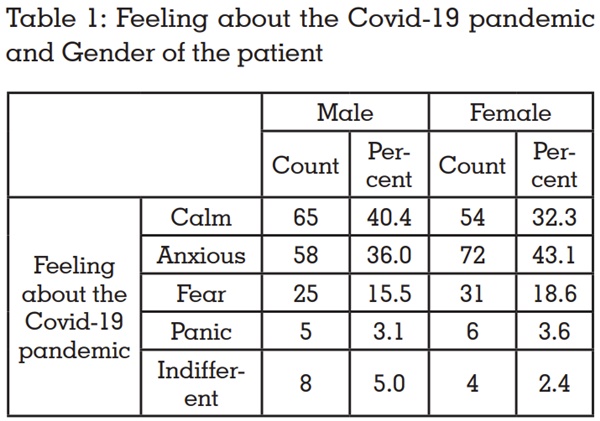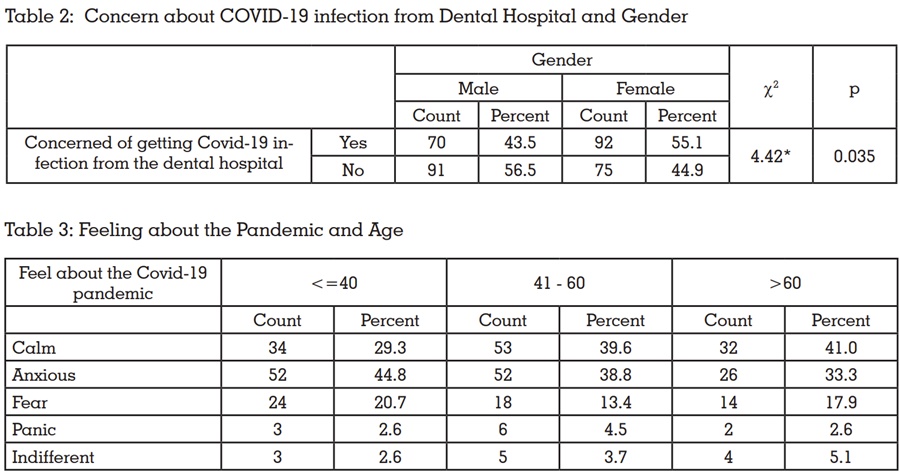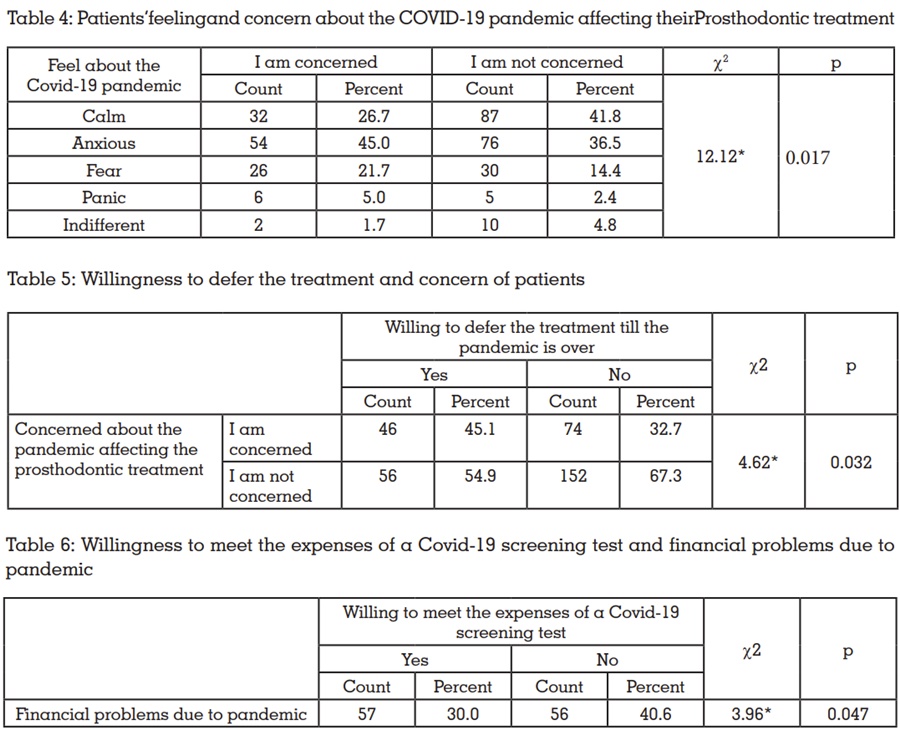

Aim: To find out the problems faced by the patients
regarding prosthodontic rehabilitation during the
COVID-19 pandemic.
Settings and Design: The study was designed to
be a cross-sectional study and was carried out in
various dental colleges and dental clinics in the
Thiruvananthapuram district. The study population
includes the patients reporting for prosthodontic
treatment in the various dental clinics and Dental
Colleges of Thiruvananthapuram district.
Materials and Methods: Data were collected by the
investigators by means of questionnaire which was
distributed either directly or via google forms. The
purpose of study was also explained and their right
to withdraw assured. Their major concern about the
prosthodontic treatment during the pandemic and
their willingness to attend an appointment were
assessed. Responses were obtained and tabulated,
for statistical analysis.
Statistical analysis: Chi-square test was used to find
association between categorical variables. Results:
328 patients participated in this study. The concern
of getting Covid-19 infection from the dental hospital
was significantly higher in females. The youth were
more anxious compared to the elderly. The financial crisis as a result of the Covid-19 pandemic influenced
the choice of Dental Hospitals.
Conclusion: The corona virus pandemic seems
to have a definite impact on the patients seeking
prosthodontic treatment as the major concern was
financial problems owing to the pandemic. There
was great concern among the patients about the
pandemic affecting their prosthodontic treatment.
Key words: Covid-19, Prosthodontic treatment, teledentistry
Prosthodontic rehabilitation of partially and
completely edentulous patients helps restore
function which significantly improves the quality
of life. Treatment and rehabilitation procedures
have been disrupted worldwide since the
COVID-19 pandemic outbreak. The emergence
of the highly infectious and novel Coronavirus
named SARS-CoV-2 first reported in Wuhan1
,
China has led to a global pandemic. The World
Health Organization (WHO) has declared it as a
public health emergency of international concern.
Globally, as of 4:32pm CET, 12 November 2021,
there have been 251,788,329 confirmed cases of
COVID-19, including 5,077,907 deaths, reported to WHO2
. The COVID-19 is a viral infection caused by
the SARS CoV-2 virus; interpersonal transmission
occurs mainly via respiratory droplets and contact,
in addition to these characteristics, asymptomatic
subjects and patients in the incubation period are
also carriers of the novel coronavirus3,4. Although
the mortality associated with COVID-19 is low, it
has a high spreading potential5
.
The worldwide population is exposed to many
different problems during the present coronavirus
(COVID-19) pandemic. The pandemic has had a
global social and economic impact as it affected
travel, business and other normal activities6
.
The isolation and lockdown procedures during
the current COVID-19 crisis has resulted in
compromised treatment protocols. Chung et
al. suggested various factors that may affect
willingness to visit a hospital like expectation
level toward a hospital, reliability of the medical
care, accessibility to the diagnosis, expenses
for diagnosis and patients’ satisfaction level7
.
Due to the widespread transmission of SARS-CoV-2 and the unique characteristics of dental
office8
, both the dental healthcare professionals
as well as the patients have an increased risk of
cross infection9
. In the first phase of pandemic
prosthodontists deferred all elective treatment
procedures like crowns, bridges, veneers, inlays,
onlays, which involve the generation of aerosols
and handled only urgent and basic procedures.
As the people learned to live with the pandemic,
Prosthodontic procedures including aerosol
generating procedures are being done using
complete personal protective equipment (PPE
suit, face-shield, double gloves, N95 mask, shoe
cover) donned by the prosthodontist as well as
the assistant10.
This study was approved by the Research
Ethics Committee of Govt. Dental College,
Thiruvananthapuram, Kerala. The study population
included the patients reporting for prosthodontic treatment in the various dental clinics and Dental
Colleges of Thiruvananthapuram district and
agreed to participate in the study. Data were
collected by the investigator after getting the
scientific and ethical clearance using a pretested
structured questionnaire. The questionnaire was
distributed either directly or via google forms in
WhatsApp. Detailed information including the
purpose, procedure, and significance of conducting
this study was explained to the patients. The
purpose of study was also explained and their right
to withdraw assured. Patients answered several
questions including personal information (age,
gender, city/state) and regarding the Covid-19
situation and their prosthodontic difficulties. Their
major concern about the prosthodontic treatment
during the pandemic and their willingness to attend
an appointment were assessed. Responses were
obtained and tabulated, for statistical analysis.
328 patients participated in this study. Out of 328,
167 were females and 161 males with a mean
age of 46.8. The majority of patients were either
not working/studying (36.3%) or has to go out
for work (35.1%), 17.4% are working/studying
from home and 11.3% are studying. Most of the
patients got updates on the Covid-19 pandemic
through various sources including social media,
newspaper, television and friends and family
(45%). 32.6% remained updated through television,
whereas 21 % opted newspapers. 15.5 % selected
social media as their news source while 4.3 %
opted friends and family.
94.8% patients were aware of the precautionary
measures to be taken to prevent Covid-19. While
95.7% patients’ practices SMS (Social distancing,
Mask, Sanitization/ Hand hygiene routinely, 4.3%
practices only wearing mask, 2.7 % hand hygiene
and 0.9 % social distancing. With respect to the
suggested restrictions imposed on the daily life,
86% are going out only for unavoidable/emergency
situations, 7.3% are not leaving home and 6.7% are going out as usual and not respecting the
restrictions. Regarding the feeling about the
coronavirus pandemic, 39.6% are anxious, 36.3% of
the patients are calm, 17.1% reported to be afraid
(fear), 3.4% are in panic and 3.7% are indifferent.
Majority of the patients’ (84.1%) prefer to go to
a dental hospital in any case of prosthodontic
emergency whereas 15.9% preferred tele dentistry.
72.6% preferred Government dental colleges for
their treatment during Covid-19 pandemic while
24.7% preferred dental clinics near their house.
The financial crisis which emerged as a result of
the Covid-19 pandemic influenced the choice of
dental hospitals for 45.1% patient’s. 90.9% patients
were comfortable going to a dental hospital during
the pandemic and 68.9% are not willing to defer
their treatment till the pandemic is over.
61.3% of the patients wanted a new prosthesis and
reported to the dental clinics. 14.3% reported a
complaint of broken denture and wanted repair or
replacement of existing denture. 13.4% complained
about pain and associated discomfort with the
existing denture (complete/removable/fixed) while
11.9% implant associated problems, 2.1% about
discomfort due to broken and sharp teeth and 1.5%
about Rehabilitation/associated treatment after
oral cancer treatment. On a 10-point scale,18.3%
graded their difficulty 5 while 14.6% graded 6 and
13.4 % graded 4.
49.7% patient had a major concern about Risk of
Covid-19 infection from the dental hospital while
34.5% had concerns about financial problems
due to pandemic, 30.2% about the possible delay in the treatment procedures. 18% were not sure
whether dental hospitals are open and 13.7%
lacked transportation facility. Most patients
(98.5%) would go to an appointment scheduled
by the dentist and 1.5% would not go. 63.4% are
concerned about the pandemic affecting their
prosthodontic treatment.
49.4% patients was concerned about getting
Covid-19 infection from the dental hospital. 90.2%
would agree if their dentist insisted upon Covid-19
screening test before the dental procedure; but
only 57.9% are willing to meet the expenses of a covid-19 screening test. 73.2% are aware of the
precautionary measures to be taken in dental
hospitals. In relation to the precautionary measures
to avoid contamination in dental offices, most
patients reported important measures such as
screening test for each patient (4.3%), disposable
PPEs for doctors (5.2%) surgical masks and the
use of face shield (9.8%), avoid crossing other
patients at reception (14.3% of the subjects) and
sanitizer made available at reception (9.5%). 75.9%
considers all the above precautionary measures
to prevent COVID -19 cross infection in dental
hospitals as important and expects the same.



In late December 2019, clusters of pneumonia
cases of unknown origin were reported from Wuhan
City in China and was identified to be caused by a
new type of Coronavirus. On March 11, 2020, WHO
declared Novel Coronavirus Disease (Covid-19)
outbreak as a pandemic11. There was surge in
Covid-19 cases during the month of October 2020
in Kerala8
& the survey was conducted during this
period when the Covid-19 cases all over Kerala was
on the rise and people had started to accept mask,
hand sanitizing, and social distancing as a part
of their routine life. Surveys may come in handy
for collecting clinically important information and
understanding the situation, helping the clinicians
to provide better dental care. The primary objective
of this survey was to assess the effects of pandemic
on Prosthodontic treatments as well as to assess
the feelings, awareness, and concerns of patients
facing this pandemic. When the survey started, it
had already been over 6 months into the pandemic.
The COVID-19 pandemic has many implications:
family organization, closing of schools, companies
and public places, changes in work routines,
isolation leading to a great fear of the helplessness,
and social insecurity12. The media and public
health generally focus on the biological and health
consequences of the virus and the pandemic.
Mental health repercussions that coincide
with emerging diseases and epidemic are not
given adequate importance13. Males tend to be
calmer than females and anxiety was greater for
females regarding the pandemic [Table 1]. This
is in accordance with studies of psychological
distress and anxiety among Chinese people in the
COVID-19 epidemic, where female respondents
showed significantly higher psychological distress
and anxiety than their males counterparts14,15. The
present survey also showed females being more
concerned about the pandemic affecting their
Prosthodontic treatment and more willingness to
defer their prosthodontic treatment. Other studies
on the distress during a disease epidemic and potentially traumatic events also showed that
women has a predilection for psychological
distress than men16,17. The concern of getting
Covid-19 infection from the dental hospital was
significantly higher in females [Table 2] and must
have been the reason for their willingness to defer
their prosthodontic treatment till the pandemic
is over.
The youth were more anxious while the elderly was
calm about the pandemic situation [Table 3]. This
result was in accordance with a recent research
which showed that younger people reported a
significantly higher prevalence of anxiety and
depressive symptoms during pandemic than older
people18,19. High consumption rates of news about
the COVID-19 pandemic have been associated
with increased levels of distress19. A study among
the Chinese citizens showed significant relation
between the mental health problems and use of
social media20. Younger population being more
addicted to social media in today’s world can
become stressed and anxious during the pandemic
and thus the survey outcome.
The patients feeling about the pandemic and
their willingness to defer the treatment were
significantly associated with their concern about
the pandemic affecting their prosthodontic
treatment. The patients who were more anxious
about the pandemic were more concerned about
their treatment being affected [Table 4 & 5]. The
survey results show a significant association of
financial problems due to the pandemic and
willingness to meet the expenses of a COVID-19
screening test before their proposed treatment
[Table 6]. The Covid-19 outbreak has had an
enormous social and economic impact across
the world. Nationwide lockdowns lasting several
weeks have brought life to a standstill, and all
the resources are being used to meet the crisis.
The imminent poverty and inequality because of
prolonged economic downswing followed by a
slow recovery, are the aftermath of this pandemic21.
Most of the patients depending on the Government
sector for their treatment belong to the below poverty line category and this must have influenced
the survey outcome. These people were affected
worse by the lockdown and unemployment was
severe as most of them would have been on daily
wages.
The Occupational Safety and Health Administration
(OSHA) has placed dental healthcare professionals
in a very high exposure risk category22. Regarding
the precautionary measures to be taken in a dental
hospital, the great majority of patients were of the
opinion that use of disposable surgical masks,
and face shields by the doctor and assistant, hand
sanitizer be available for patients at reception,
avoid crossing other patients at reception, Personal
protective equipment for doctors, and screening
tests were all considered important. This indicates
that patients are aware of these recommendations,
and strict adherence to the protocol will improve
the patient/Prosthodontist relationship.
Teledentistry is effective in having a specialist
consultation without the need to visit a dentist during
this pandemic. The accuracy of a diagnosis made
face-to-face have an important role in prosthodontic
health care delivery, and many patients will need to
visit the dental office. Emergency management of
prosthodontic emergencies like crown dislodgment
or denture breakage can be managed by guiding
the patient on what has to be done23. Moreover,
the teledentistry in prosthodontic patient care
has limited application. Teledentistry can be
employed effectively for communication between
the Prosthodontist and the lab technician. Dental
health care professionals are extremely exposed
to COVID-19 infection and are at risk due to the
close contact with patients and the exposure to
biological fluids and aerosol/droplets production
during various dental procedures24. The absence of
adequate precautions in the dental clinics exposes
patients to contamination25. The conventional
prosthetic workflow involves many steps which can
result in viral contamination and cross infection
among the dental professionals. According to
Peng et al 2020, saliva and blood of SARS COV-2
infected patients remaining on the impressions can contaminate the stone models also26. The digital
workflow thus helps in reducing the steps and time
required as well as the risk of cross contamination
and infection of the personnel27–30.
The limitations of this study include the cross-sectional design and the reliance on self-reported
questionnaires.
The corona virus pandemic seems to have a definite
impact on the patients seeking prosthodontic
treatment. The concern of getting Covid-19
infection from the dental hospital was significantly
higher in females. The major concern in seeking
prosthodontic care during the pandemic was
financial problems owing to the pandemic. The
patients who were anxious about the pandemic
and the patients who were willing to defer their
treatment till the pandemic gets over were greatly
concerned about the pandemic affecting their
prosthodontic treatment. The use of disposable
surgical masks, and face shields by the doctor
and assistant, hand sanitizer be available for
patients at reception, avoid crossing other patients
at reception, Personal protective equipment for
doctors, and screening tests were all considered
important by the patients attending various dental
hospitals.